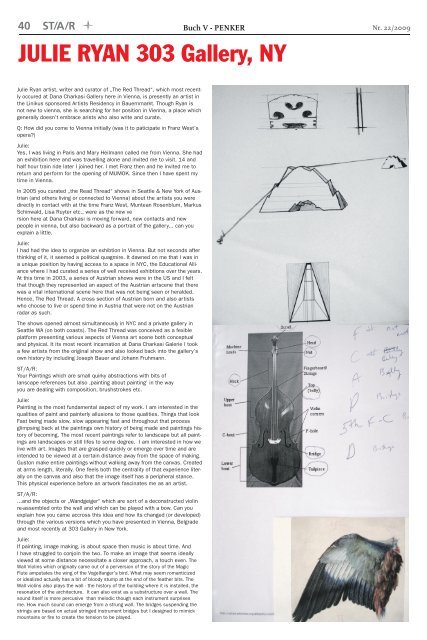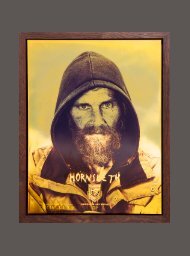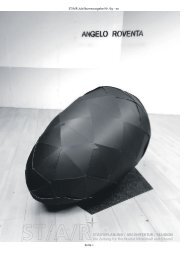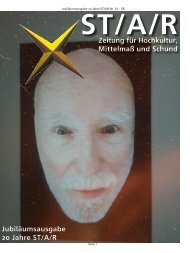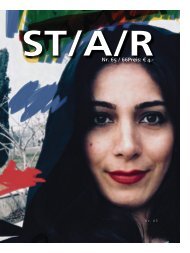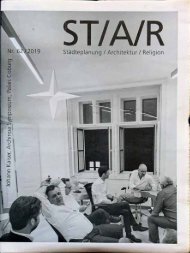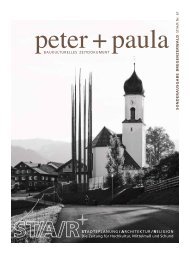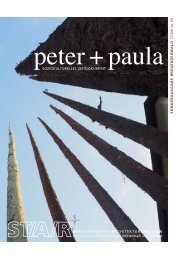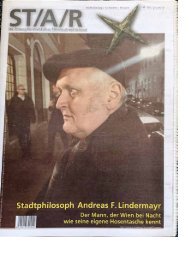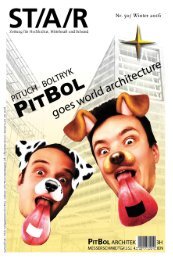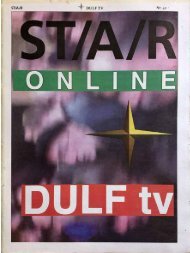ST:A:R_22
Sie wollen auch ein ePaper? Erhöhen Sie die Reichweite Ihrer Titel.
YUMPU macht aus Druck-PDFs automatisch weboptimierte ePaper, die Google liebt.
40 <strong>ST</strong>/A/R<br />
Buch V - PENKER Nr. <strong>22</strong>/2009<br />
JULIE RYAN 303 Gallery, NY<br />
Julie Ryan artist, writer and curator of „The Red Thread“, which most recently<br />
occured at Dana Charkasi Gallery here in Vienna, is presently an artist in<br />
the Linikus sponsored Artists Residency in Bauernmarkt. Though Ryan is<br />
not new to vienna, she is searching for her position in Vienna, a place which<br />
generally doesn’t embrace arists who also write and curate.<br />
Q: How did you come to Vienna initially (was it to paticipate in Franz West’s<br />
opera?)<br />
Julie:<br />
Yes, I was living in Paris and Mary Heilmann called me from Vienna. She had<br />
an exhibition here and was travelling alone and invited me to visit. 14 and<br />
half hour train ride later I joined her. I met Franz then and he invited me to<br />
return and perform for the opening of MUMOK. Since then I have spent my<br />
time in Vienna.<br />
In 2005 you curated „the Read Thread“ shows in Seattle & New York of Austrian<br />
(and others living or connected to Vienna) about the artists you were<br />
directly in contact with at the time Franz West, Muntean Rosenblum, Markus<br />
Schinwald, Lisa Ruyter etc., were as the new ve<br />
rsion here at Dana Charkasi is moving forward, new contacts and new<br />
people in vienna, but also backward as a portrait of the gallery... can you<br />
explain a little.<br />
Julie:<br />
I had had the idea to organize an exhibtion in Vienna. But not seconds after<br />
thinking of it, it seemed a political quagmire. It dawned on me that I was in<br />
a unique position by having access to a space in NYC, the Educational Alliance<br />
where I had curated a series of well received exhibtions over the years.<br />
At this time in 2003, a series of Austrian shows were in the US and I felt<br />
that though they represented an aspect of the Austrian artscene that there<br />
was a vital international scene here that was not being seen or heralded.<br />
Hence, The Red Thread. A cross section of Austrian born and also artists<br />
who choose to live or spend time in Austria that were not on the Austrian<br />
radar as such.<br />
The shows opened almost simultaneously in NYC and a private gallery in<br />
Seattle WA (on both coasts). The Red Thread was conceived as a fexible<br />
platform presenting various aspects of Vienna art scene both conceptual<br />
and physical. It its most recent incarnation at Dana Charkasi Galerie I took<br />
a few artists from the original show and also looked back into the gallery’s<br />
own history by including Joseph Bauer and Johann Fruhmann.<br />
<strong>ST</strong>/A/R:<br />
Your Paintings which are small quirky abstractions with bits of<br />
lanscape references but also ‚painting about painting’ in the way<br />
you are dealing with composition, brushstrokes etc.<br />
Julie:<br />
Painting is the most fundamental aspect of my work. I am interested in the<br />
qualities of paint and painterly allusions to those qualities. Things that look<br />
Fast being made slow, slow appearing fast and throughout that process<br />
glimpsing back at the paintings own history of being made and paintings history<br />
of becoming. The most recent paintings refer to landscape but all paintings<br />
are landscapes or still lifes to some degree. I am interested in how we<br />
live with art. Images that are grasped quickly or emerge over time and are<br />
intended to be viewed at a certain distance away from the space of making.<br />
Guston make entire paintings without walking away from the canvas. Created<br />
at arms length, literally. One feels both the centrality of that experience literally<br />
on the canvas and also that the image itself has a peripheral stance.<br />
This physical experience before an artwork fascinates me as an artist.<br />
<strong>ST</strong>/A/R:<br />
...and the objects or „Wandgeiger“ which are sort of a deconstructed violin<br />
re-assembled onto the wall and which can be played with a bow. Can you<br />
explain how you came accross this idea and how its changed (or developed)<br />
through the various versions which you have presented in Vienna, Belgrade<br />
and most recently at 303 Gallery in New York.<br />
Julie:<br />
If painting, image making, is about space then music is about time. And<br />
I have struggled to conjoin the two. To make an image that seems ideally<br />
viewed at some distance necessitate a closer approach, a touch even. The<br />
Wall Violins which originally came out of a perversion of the story of the Magic<br />
Flute amputates the wing of the Vogelfanger’s bird. What may seem romanticized<br />
or idealized actually has a bit of bloody stump at the end of the feather bits. The<br />
Wall violins also plays the wall - the history of the building where it is installed, the<br />
resonation of the architecture. It can also exist as a substructure over a wall. The<br />
sound itself is more percusive than melodic though each instrument surprises<br />
me. How much sound can emerge from a strung wall. The bridges suspending the<br />
strings are based on actual stringed instrument bridges but I designed to mimick<br />
mountains or fi re to create the tension to be played.


